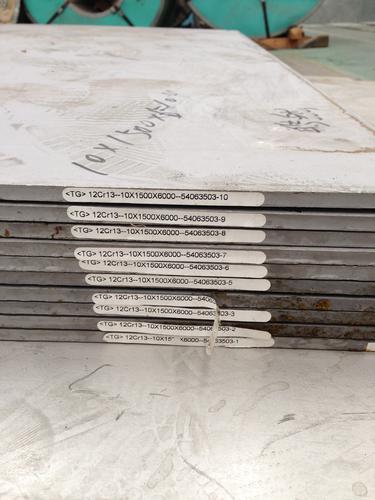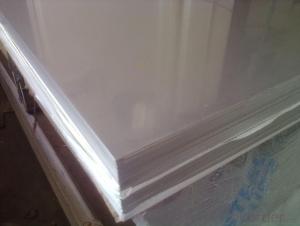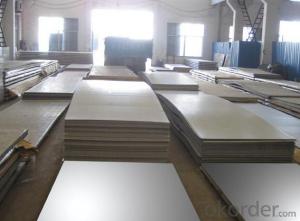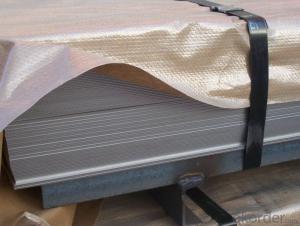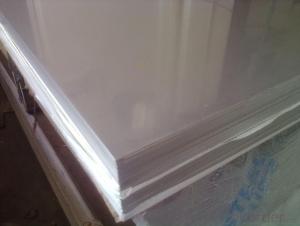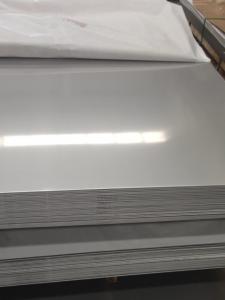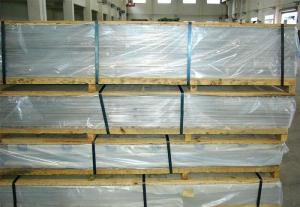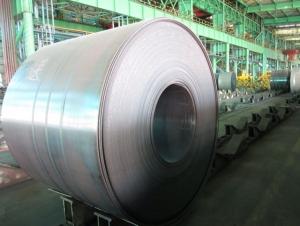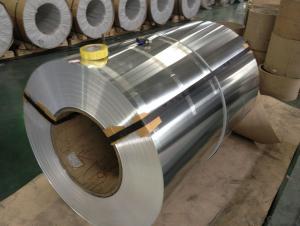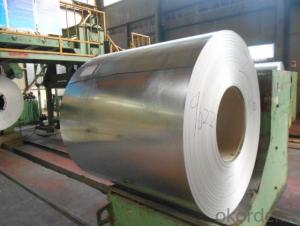Stainless Steel Cold Rolled Sheet With Best Price In Warehouse
- Loading Port:
- Shanghai
- Payment Terms:
- TT or LC
- Min Order Qty:
- 4 m.t.
- Supply Capability:
- 5000 m.t./month
OKorder Service Pledge
OKorder Financial Service
You Might Also Like
1.Structure of Product Description
We are one of the biggest manufactures towards the stainless steel sheet/coil/checkered sheet/mirror finished sheet, and we also have a best reputation in the field of decoration , construction, etc.
Cold rolled Stainless steel sheet, hot rolled stainless steel checkered sheet is widely used in the field of construction field and decoration field, etc. There are many different grades, such as:The detailed grade are as follows: 201, 202, 301, 304, 316, 410, 420, 430, etc.
2. Main features of the product
a. Competitive price
b. Frist-Class Service.
c. Very Best Price.
3. Image.
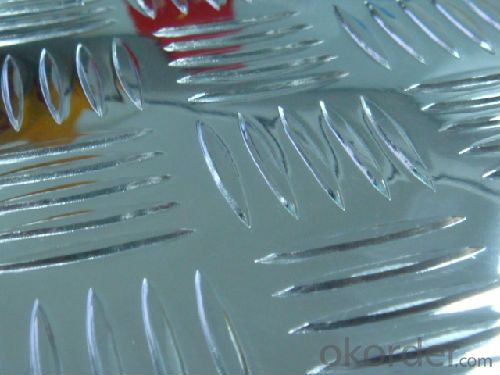
4. Product detailed sizes:
1000mm*2000mm, 1219mm*2438mm,1220mm*2440mm, 1250mm*2500mm,1500mm*3000mm, etc.
5. FAQ:
What is the quality standard?
---Usually our standard is GB3880-2006 or else.
What is the width range?
---It is from 1000mm to 2500mm, etc.
What is the length range?
---It is from 2000mm to 6000mm, etc.
What is the MOQ for your products yet?
---Normally it is around 3 tons/each size.
What is your mainly products?
---Normally they are stainless steel sheet, stainless steel coil, stainless steel checkered sheet, stainless steel mirror finished sheet, color coated stainless steel sheet, etc.
How many times have youever imported it from China before?
- Q: Can stainless steel sheets be used for decorative backsplashes?
- Yes, stainless steel sheets can be used for decorative backsplashes. Their sleek and modern appearance, durability, and resistance to stains and corrosion make them a popular choice for adding a stylish and functional element to kitchens or other spaces.
- Q: What does "80 wire" stainless steel plate mean? How much more expensive than the average stainless steel plate?
- Stainless steel terminology, the general thickness of C to calculate the negative difference, the 1 C is 0.01MM, so 80C is 0.8MM. 0.8MM thick stainless steel with different thickness, different prices, generally about Yuegui thin.
- Q: How do you remove oil stains from stainless steel sheets?
- In order to eliminate oil stains from stainless steel sheets, the following steps can be followed: 1. To start, utilize a clean cloth or paper towel to wipe the affected area and remove any excess oil or grease. 2. Combine a mild dish soap with warm water in a bowl or bucket. Dip a soft sponge or cloth into the soapy mixture and gently scrub the stained area using circular motions. 3. For more stubborn stains, a non-abrasive cleaner specifically designed for stainless steel can be employed. Apply a small amount of the cleaner to the stained area and utilize a soft cloth to rub it in. It is important to adhere to the manufacturer's instructions for the cleaner. 4. Thoroughly rinse the area with warm water to eliminate any soap residue. 5. To further restore shine and eliminate any remaining stains, a paste can be created by combining baking soda and water. Apply the paste to the stained area and allow it to sit for a few minutes. Then, gently scrub with a soft cloth or sponge. Rinse with warm water and dry with a clean towel. 6. To prevent future stains, it is advisable to consider using a stainless steel cleaner or polish. These products can aid in maintaining shine and making it easier to clean any spills or stains that may occur. It is essential to always test any cleaning product or method on a small, inconspicuous area of the stainless steel sheet before applying it to the entire surface. Additionally, it is important to avoid using abrasive materials or scrub brushes with harsh bristles as they can cause scratches on the stainless steel.
- Q: What is the difference between stainless steel sheets and plates?
- Stainless steel sheets and plates are both types of flat metal materials that are widely used in various industries and applications. However, there are a few key differences between them. 1. Thickness: Stainless steel sheets are generally thinner than plates. Sheets typically have a thickness ranging from 0.4mm to 4mm, whereas plates are usually thicker, starting from 4mm and going up to several inches. 2. Size: Sheets are typically available in standard sizes of 4ft x 8ft or 5ft x 10ft, while plates are usually available in larger sizes and can be customized to specific dimensions. Plates are commonly used for heavy-duty applications that require greater strength and durability. 3. Weight: Due to their difference in thickness, plates are generally heavier than sheets. This makes plates more suitable for applications where weight-bearing capacity is critical, such as construction, shipbuilding, or industrial equipment. 4. Applications: Stainless steel sheets are commonly used for decorative purposes, architectural applications, and smaller-scale projects such as kitchen backsplashes or countertops. Plates, on the other hand, are preferred for structural components, machinery parts, and load-bearing applications like bridges, tanks, or pressure vessels. 5. Cost: Stainless steel plates are generally more expensive than sheets due to their larger size and higher thickness. Sheets, being thinner and smaller, are usually more cost-effective and easily accessible. In summary, the key differences between stainless steel sheets and plates are their thickness, size, weight, applications, and cost. It is important to consider these factors when choosing between the two materials for a specific project or application.
- Q: What are the different surface textures available for stainless steel sheets?
- There are several different surface textures available for stainless steel sheets, including brushed, mirror, satin, embossed, and patterned.
- Q: Are stainless steel sheets resistant to crevice corrosion?
- Yes, stainless steel sheets are generally resistant to crevice corrosion. Crevice corrosion occurs in confined spaces, such as crevices or gaps between two surfaces, where oxygen and other corrosive agents are limited. Stainless steel sheets are made primarily of iron, chromium, and other alloying elements that create a protective oxide layer on the surface, preventing the penetration of corrosive agents. This oxide layer acts as a barrier, making stainless steel highly resistant to crevice corrosion. However, it's important to note that the resistance to crevice corrosion can vary depending on the specific grade and composition of the stainless steel, as well as the environmental conditions it is exposed to.
- Q: Are stainless steel sheets suitable for chemical tanks?
- Chemical tanks can indeed make use of stainless steel sheets. Stainless steel is widely recognized for its exceptional resistance to corrosion, rendering it an ideal material for the containment and transportation of chemicals. Its remarkable strength and durability enable it to withstand the harshest chemicals and extreme temperatures. Moreover, stainless steel boasts a smooth and non-porous surface, preventing the absorption of chemicals and facilitating effortless cleaning. Furthermore, stainless steel exhibits non-reactivity, ensuring the preservation of the stored substances' integrity by not reacting with most chemicals. All in all, stainless steel sheets are an esteemed and dependable choice for chemical tanks due to their corrosion resistance, strength, durability, and non-reactivity.
- Q: What are the common grades of stainless steel sheets used in construction?
- Stainless steel sheets used in construction are typically classified into three common grades: austenitic, ferritic, and duplex stainless steels. The most widely used grades are austenitic stainless steels, including 304 and 316, which are known for their excellent corrosion resistance and high strength. These grades are commonly applied in architectural applications, roofing, cladding, and structural components. On the other hand, ferritic stainless steels, represented by 430, possess good corrosion resistance and high toughness, making them suitable for applications that prioritize strength and durability. They are often utilized for decorative purposes, interior design elements, and automotive trim. Meanwhile, duplex stainless steels like 2205 offer a combination of outstanding corrosion resistance and high strength, making them ideal for heavy-duty construction applications. These grades are frequently used in bridges, offshore structures, and industrial plants where superior strength and resistance to chloride-induced stress corrosion cracking are necessary. It should be emphasized that the choice of stainless steel sheet grade depends on the specific requirements of the construction project, including the environment, load-bearing capacity, and aesthetic considerations. Seeking advice from a materials engineer or a stainless steel supplier can help determine the most suitable grade for a particular construction application.
- Q: What is the fire resistance rating of stainless steel sheets?
- Stainless steel sheets lack an inherent fire resistance rating as they are not naturally fire resistant materials. Nevertheless, stainless steel can demonstrate commendable fire resistance attributes due to its high melting point and low thermal conductivity. Consequently, stainless steel sheets are less prone to melting or transferring heat during a fire, thus impeding the spread of flames. Furthermore, stainless steel possesses corrosion resistance, which further bolsters its performance in fire scenarios. However, it should be emphasized that the fire resistance of a structure or system hinges on a combination of diverse factors, encompassing the comprehensive design, construction, and utilization of fire-resistant materials. Consequently, the fire resistance rating of stainless steel sheets may fluctuate depending on the specific application and the overarching fire protection measures implemented.
- Q: Can stainless steel sheets be cut to custom sizes?
- Yes, stainless steel sheets can be cut to custom sizes. Stainless steel is a versatile material that can be easily cut and fabricated into various shapes and sizes to meet specific requirements. There are several methods for cutting stainless steel sheets, including shearing, laser cutting, water jet cutting, and plasma cutting. These techniques allow for precise and accurate cuts, ensuring that the stainless steel sheets can be tailored to the desired dimensions. Whether it is for industrial, commercial, or residential applications, stainless steel sheets can be easily customized to fit specific needs.
Send your message to us
Stainless Steel Cold Rolled Sheet With Best Price In Warehouse
- Loading Port:
- Shanghai
- Payment Terms:
- TT or LC
- Min Order Qty:
- 4 m.t.
- Supply Capability:
- 5000 m.t./month
OKorder Service Pledge
OKorder Financial Service
Similar products
Hot products
Hot Searches
Related keywords



